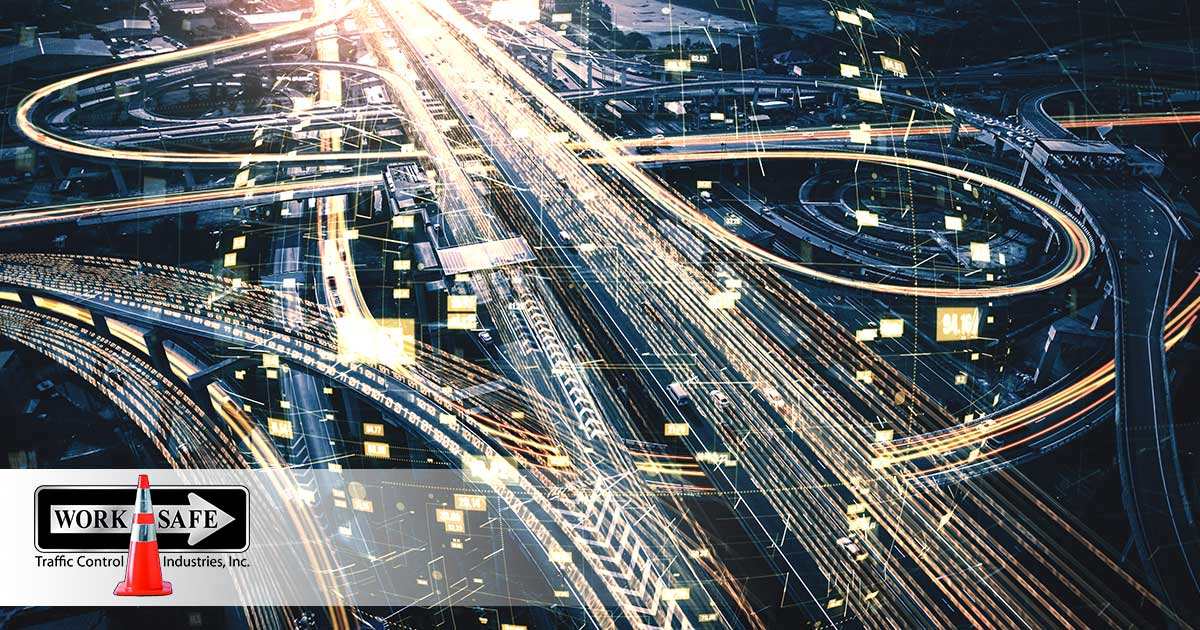
Smart work zones, or SWZs, are established to prevent road hazards during freeway or other roadway construction and repair work. Motorists must be protected from accidents that can arise from the surprise of a lane closure, a lane shift, or reduced speeds, and Worksafe Traffic Control Industries can help.
At the same time, road workers must have a safe space to move equipment and tools while effectively completing a road job without fear of injury or death due to a traffic incident. This is the purpose of implementing a smart work zone. A smart work zone includes safety traffic signs that not only manage traffic and reduce bottlenecks while road construction is underway but also protect the safety of motorists and road construction workers.
What is a Smart Work Zone System
A smart work zone system can be implemented on freeways in either urban, suburban, or rural communities when road situations cause changes in travel speed, flow, or direction. The system uses traffic signs and digital technology to inform motorists about upcoming traffic and/or lane changes and other roadway situations that are different.
A smart work zone will use safety traffic signs and other devices to give information and warn motorists of roadway situations, such as “Construction Ahead – Expect Delays.” Typical signage is supplemented with other electronic traffic and smart work zone devices to give motorists a complete picture of what to expect and how to react.
The goal of a smart work zone is to use the right traffic safety signs to make an area safer during road reconstruction, after a road accident, or while performing road maintenance. Two primary systems can be used in conjunction with smart work zone systems, including:
TIPS (Traffic Information & Prediction System)
TIPS uses different traffic detection devices like traffic safety signs, radar sensors, microcontrollers, and RF transmission devices to detect vehicle travel on freeways. The system will then process the traffic data and post an appropriate message to electronic signs that can inform or warn drivers of freeway delays ahead.
ATIS (Advanced Traveler Information System)
This electronic roadway system was established to help drivers maneuver road incidents, bad weather, or traffic congestion by supplying information to travelers that traffic management centers distribute. An ATIS system can suggest alternate routes around construction zones, warn of lane restrictions, and remind drivers of recommended speeds.
How to Establish a Smart Work Zone
A smart work zone is established to deliver real-time information to motorists to help prevent knee-jerk reactions in construction zones. For example, sudden braking or erratic swerving are two of the most common causes of accidents due to unexpected freeway changes.
When accurate and reliable traffic information is provided at reasonable intervals to motorists traveling through work zones, drivers and workers are calmer, safer, and able to make better driving decisions. A smart work zone can deliver the right information for motorists to make informed decisions, such as choosing an alternate route instead of traveling through the work zone.
Here are five steps to establishing a smart work zone using safety traffic signs and electronic information signage.
1. Set Up Queued Warnings
Set up an advanced warning message using safety traffic signs positioned upstream from the work zone to warn approaching vehicles to be prepared to stop or slow down. An early queue warning will reduce the number of server collisions and can reduce delays as traffic moves through the work zone.
2. Post Travel Delay Information
Post-real-time information can inform motorists of changing travel times using dynamic signs to reduce motorist frustration from unexpected wait times. Travel delay monitoring should produce real-time travel delay information, which may change depending on freeway congestion, time of day, or the scope of the roadwork project.
3. Give Travelers Alternate Route Information
Another function of safety traffic signs is to increase driver awareness of freeway travel times and alternate routes they can travel to arrive at their destination faster. Alternate route signage will also help decongest traffic and improve safety for both drivers and construction workers by reducing traffic volume.
4. Control Driver Speeds
Variable Speed Limit Trailers and Variable Speed Limit electronic signage can help control vehicular speed, increasing traffic throughput and reducing accidents. When driver speeds are varied or reduced according to local road conditions, road work intensity, or traffic congestion, the result is fewer collisions, safer work zones, and better traffic flow.
5. Lane Merge Signage
Dynamic lane merging signs help control the points at which motorists merge along the roadway when approaching or leaving a work zone. Lane merging can be a point of contention among motorists, especially during peak travel hours. smart work zones with Dynamic Lane Merging signage can result in fewer accidents and faster throughput.
Always work with the construction contractor when deploying a smart work zone to allow for the best placement and usage of safety traffic signs throughout work zones. Contact us to order your own design today!

